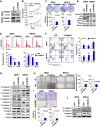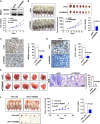TMEM65 promotes gastric tumorigenesis by targeting YWHAZ to activate PI3K-Akt-mTOR pathway and is a therapeutic target
- PMID: 38341472
- PMCID: PMC10959749
- DOI: 10.1038/s41388-024-02959-9
TMEM65 promotes gastric tumorigenesis by targeting YWHAZ to activate PI3K-Akt-mTOR pathway and is a therapeutic target
Abstract
Copy number alterations are crucial for the development of gastric cancer (GC). Here, we identified Transmembrane Protein 65 (TMEM65) amplification by genomic hybridization microarray to profile copy-number variations in GC. TMEM65 mRNA level was significantly up-regulated in GC compared to adjacent normal tissues, and was positively associated with TMEM65 amplification. High TMEM65 expression or DNA copy number predicts poor prognosis (P < 0.05) in GC. Furtherly, GC patients with TMEM65 amplification (n = 129) or overexpression (n = 78) significantly associated with shortened survival. Ectopic expression of TMEM65 significantly promoted cell proliferation, cell cycle progression and cell migration/invasion ability, but inhibited apoptosis (all P < 0.05). Conversely, silencing of TMEM65 in GC cells showed opposite abilities on cell function in vitro and suppressed tumor growth and lung metastasis in vivo (all P < 0.01). Moreover, TMEM65 depletion by VNP-encapsulated TMEM65-siRNA significantly suppressed tumor growth in subcutaneous xenograft model. Mechanistically, TMEM65 exerted oncogenic effects through activating PI3K-Akt-mTOR signaling pathway, as evidenced of increased expression of key regulators (p-Akt, p-GSK-3β, p-mTOR) by Western blot. YWHAZ (Tyrosine 3-Monooxygenase/Tryptophan 5-Monooxygenase) was identified as a direct downstream effector of TMEM65. Direct binding of TMEM65 with YWHAZ in the cytoplasm inhibited ubiquitin-mediated degradation of YWHAZ. Moreover, oncogenic effect of TMEM65 was partly dependent on YWHAZ. In conclusion, TMEM65 promotes gastric tumorigenesis by activating PI3K-Akt-mTOR signaling via cooperating with YWHAZ. TMEM65 overexpression may serve as an independent new biomarker and is a therapeutic target in GC.
© 2024. The Author(s).
Conflict of interest statement
The authors declare no competing interests.
Figures






Similar articles
-
Anthrax toxin receptor 1/tumor endothelial marker 8 promotes gastric cancer progression through activation of the PI3K/AKT/mTOR signaling pathway.Cancer Sci. 2020 Apr;111(4):1132-1145. doi: 10.1111/cas.14326. Epub 2020 Feb 19. Cancer Sci. 2020. PMID: 31977138 Free PMC article.
-
NUCKS1 promotes gastric cancer cell aggressiveness by upregulating IGF-1R and subsequently activating the PI3K/Akt/mTOR signaling pathway.Carcinogenesis. 2019 Apr 29;40(2):370-379. doi: 10.1093/carcin/bgy142. Carcinogenesis. 2019. PMID: 30371738
-
NUF2 promotes tumorigenesis by interacting with HNRNPA2B1 via PI3K/AKT/mTOR pathway in ovarian cancer.J Ovarian Res. 2023 Jan 20;16(1):17. doi: 10.1186/s13048-023-01101-9. J Ovarian Res. 2023. PMID: 36670423 Free PMC article.
-
Circular RNA hsa_circ_0010882 promotes the progression of gastric cancer via regulation of the PI3K/Akt/mTOR signaling pathway.Eur Rev Med Pharmacol Sci. 2020 Feb;24(3):1142-1151. doi: 10.26355/eurrev_202002_20165. Eur Rev Med Pharmacol Sci. 2020. PMID: 32096170
-
FOXD1-AS1 regulates FOXD1 translation and promotes gastric cancer progression and chemoresistance by activating the PI3K/AKT/mTOR pathway.Mol Oncol. 2021 Jan;15(1):299-316. doi: 10.1002/1878-0261.12728. Epub 2020 Nov 14. Mol Oncol. 2021. PMID: 32460412 Free PMC article.
Cited by
-
Implication of protein post translational modifications in gastric cancer.Front Cell Dev Biol. 2025 Feb 4;13:1523958. doi: 10.3389/fcell.2025.1523958. eCollection 2025. Front Cell Dev Biol. 2025. PMID: 39968176 Free PMC article. Review.
-
Extracellular vesicles derived from salivary gland stem cells cultured on microwell scaffolds loaded with WNT3A promote the recovery of salivary gland function damaged by radiation via the YWHAZ-PI3K-AKT pathway.Bioact Mater. 2025 Jun 17;52:492-510. doi: 10.1016/j.bioactmat.2025.06.024. eCollection 2025 Oct. Bioact Mater. 2025. PMID: 40599344 Free PMC article.
-
Prognosis and Treatment of Gastric Cancer: A 2024 Update.Cancers (Basel). 2024 Apr 27;16(9):1708. doi: 10.3390/cancers16091708. Cancers (Basel). 2024. PMID: 38730659 Free PMC article. Review.
-
Integrative analysis of a novel signature incorporating metabolism and stemness-related genes for risk stratification and assessing clinical outcomes and therapeutic responses in lung adenocarcinoma.BMC Cancer. 2025 Apr 1;25(1):591. doi: 10.1186/s12885-025-13984-6. BMC Cancer. 2025. PMID: 40170009 Free PMC article.
References
MeSH terms
Substances
LinkOut - more resources
Full Text Sources
Medical
Molecular Biology Databases
Miscellaneous

